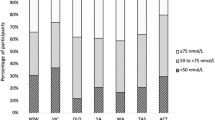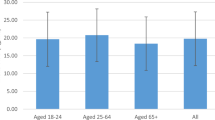Abstract
Objective:
To investigate determinants (pathophysiologic and physiologic, behavioural and lifestyle) of vitamin D status in Irish Crohn's disease (CD) patients.
Design:
A cross-sectional observational study.
Setting:
Cork City, Ireland (52°N).
Subjects:
Crohn's Disease patients (n=58; mean age 38.1 years) were recruited from Cork University Hospital.
Results:
Fifty and nineteen percent of Irish CD patients were vitamin D deficient (defined by serum 25 hydroxyvitamin (OH) D levels <50 nmol/l) during winter and summer, respectively. Multiple regression analysis showed that summer-time serum 25 (OH) D levels were positively associated with use of vitamin D supplements (P=0.033) and negatively associated with smoking (P=0.006) and being male (P=0.063). During winter-time, use of vitamin D supplements (P=0.041) and sun habits (P=0.066) were positively associated, whereas small intestinal involvement (P=0.005) and body mass index (BMI) (P=0.083) were negatively associated with serum 25 (OH) D levels. There was no significant association between other non-pathophysiologic (age, dietary calcium or vitamin D) or pathophysiologic factors (steroid use, resection), and serum 25 (OH) D levels, at either season. Approximately 41 and 60% of the total variation in summer- and winter-time serum 25 (OH) D, respectively, was explained by this model.
Conclusion:
A high proportion of Irish CD patents had some level of vitamin D deficiency (<50 nmol/l) during late-wintertime. Use of regular low-dose supplemental vitamin D, particularly by patients with small intestinal involvement, cessation of smoking and adequate, but responsible, exposure to summer sunlight as well as maintaining BMI in the normal range could help maintain adequate vitamin D levels during wintertime.
This is a preview of subscription content, access via your institution
Access options
Subscribe to this journal
Receive 12 print issues and online access
$259.00 per year
only $21.58 per issue
Buy this article
- Purchase on Springer Link
- Instant access to full article PDF
Prices may be subject to local taxes which are calculated during checkout
Similar content being viewed by others
References
Andersen R, Mølgaard C, Skivgaard LT, Brot C, Cashman KD, Chabros E et al. (2005). Prevalence of hypovitaminosis D in two risk groups in European countries. Eur J Clin Nutr 59, 533–541.
Andreassen H, Rix M, Brot C, Eskildsen P (1998). Regulators of calcium homeostasis and bone mineral density in patients with Crohn's disease. Scand J Gastroenterol 33, 1087–1093.
Arnaud SB, Goldsmith RS, Lambert PW, Go VL (1975). 25-Hydroxyvitamin D3: evidence of an enterohepatic circulation in man. Proc Soc Exp Biol Med 149, 570–572.
Arunabh S, Pollack S, Yeh J, Aloia JF (2003). Body fat content and 25-hydroxyvitamin D levels in healthy women. J Clin Endocrnol Metab 88, 157–161.
Bates CJ, Carter GD, Mishra GD, O'Shea D, Jones J, Prentice A (2003). In a population study, can parathyroid hormone aid the definition of adequate vitamin D status? A study of people aged 65 years and over from the British National Diet and Nutrition Survey. Osteoporos Int 4, 152–159.
Brot C, Jorgensen NR, Sørensen OH (1999). The influence of smoking on vitamin D status and calcium metabolism. Eur J Clin Nutr 53, 920–926.
Burnand B, Sloutskis D, Gianoli F, Cornuz J, Rickenbach M, Paccaud F et al. (1992). Serum 25-hydroxyvitamin D: distribution and determinants in the Swiss population. Am J Clin Nutr 56, 537–542.
Collins A, O'Brien MM, Flynn A, Cashman KD, Kiely M (2003). Comparison of a 69-item food frequency questionnaire (FFQ) with a 14-day dietary (DH) to estimate vitamin D intakes in 50–75-year-old Irish women. Proc Nutr Soc 62, 21A.
Cosnes J (2004). Tobacco and IBD: relevance in the understanding of disease mechanisms and clinical practice. Best Pract Res Clin Gastroenterol 18, 481–496.
Doyle L, Jewell C, Mullen A, Nugent AP, Roche HM, Cashman KD (2005). Effect of dietary supplementation with conjugated linoleic acid on markers of calcium and bone metabolism in healthy adult men. Eur J Clin Nutr 59, 432–440.
Driscoll Jr RH, Meredith SC, Sitrin M, Rosenberg IH (1982). Vitamin D deficiency and bone disease in patients with Crohn's disease. Gastroenterology 83, 1252–1258.
Food Safety Authority of Ireland (1999). Recommended Dietary Allowances for Ireland. Government Publication Sales Office: Dublin.
Food Standards Agency (2002). Food Portion Sizes, 3rd ed. TSO: London.
Freaney R, McBrinn Y, McKenna MJ (1993). Secondary hyperparathyroidism in elderly people: combined effect of renal insufficiency and vitamin D deficiency. Am J Clin Nutr 58, 187–191.
Geerling BJ, Badart-Smook A, Stockbrugger RW, Brummer RJ (1998). Comprehensive nutritional status in patients with long-standing Crohn disease currently in remission. Am J Clin Nutr 67, 919–926.
Haderslev KV, Jeppesen PB, Sorensen HA, Mortensen PB, Staun M (2003). Vitamin D status and measurements of markers of bone metabolism in patients with small intestinal resection. Gut 52, 653–658.
Harries AD, Brown R, Heatley RV, Williams LA, Woodhead S, Rhodes J (1985). Vitamin D status in Crohn's disease: association with nutrition and disease activity. Gut 26, 1197–1203.
Heaney RP, Weaver CM (2003). Calcium and vitamin D. Endocrinol Metab Clin North Am 32, 181–194.
Hill TR, O'Brien MM, Kiely M, Flynn A, Cashman KD (2004). Vitamin D intakes in 18–64 year-old Irish adults. Eur J Clin Nutr 58, 1509–1517.
Hill TR, Collins A, O'Brien MM, Kiely M, Flynn A, Cashman KD (2005a). Vitamin D intake and status in Irish postmenopausal women. Eur J Clin Nutr 59, 404–410.
Hill TR, Collins A, O'Brien M, Kiely M, Flynn A, Cashman KD (2005b). Determinants of vitamin D status in Irish postmenopausal women. Publ Health Nutr (in press).
Holick MF (1995). Environmental factors that influence the cutaneous production of vitamin D. Am J Clin Nutr 61, 638S–645S.
Holick MF (2002). Vitamin D: the underappreciated D-lightful hormone that is important for skeletal and cellular health. Curr Opin Endocrinol Diabetes 9, 87–98.
Holick MF (2004). Vitamin D: importance in the prevention of cancers, type-1 diabetes, heart disease and osteoporosis. Am J Clin Nutr 79, 362–371.
Ilich JZ, Brownbill RA, Tamborini L, Crncevic-Orlic Z (2002). To drink or not to drink: how are alcohol, caffeine and past smoking related to bone mineral density in elderly women? J Am Coll Nutr 21, 536–544.
Jacques PF, Felson DT, Tucker KL, Mahnken B, Wilson PWF, Rosenberg IH et al. (1997). Plasma 25-hydroxyvitamin D and its determinants in an elderly population sample. Am J Clin Nutr 66, 929–936.
Jahnsen J, Falch JA, Mowinckel P, Aadland E (2002). Vitamin D status, parathyroid hormone and bone mineral density in patients with inflammatory bowel disease. Scand J Gastroenterol 37, 192–199.
Lamberg-Allardt CJ, Outila TA, Kärkkäinen MU, Rita HJ, Valsta LM (2001). Vitamin D deficiency and bone health in healthy adults in Finland: could this be a concern in other parts of Europe? J Bone Mineral Res 16, 2066–2073.
Lips P (1998). Does calcium intake change vitamin D requirements? In: Burckhardt P, Dawson-Hughes B, Heaney RP (eds). Nutritional Aspects of Osteoporosis. Serono Symposium. Springer-Verlag: New York, pp 262–267.
Lips P (2004). Which circulating level of 25-hydroxyvitamin D is appropriate? J Steroid Biochem Mol Biol 89–90, 611–614.
MacLaughlin J, Holick MF (1985). Aging decreases the capacity of human skin to produce vitamin D3 . J Clin Invest 76, 1536–1538.
McCarthy D, Duggan P, O'Brien M, Kiely M, McCarthy J, Shanahan F et al. (2005). Seasonality of vitamin D status and bone turnover in patients with Crohn's disease. Aliment Pharmacol Ther 21, 1073–1083.
McKenna MJ (1992). Differences in vitamin D status between countries in young adults and the elderly. Am J Clin Nutr 93, 69–77.
Ministry of Agriculture, Fisheries and Food (MAFF) (1997). Food Portion Sizes. London: The Stationary Office.
Ovesen L, Andersen R, Jakobsen J (2003). Geographical differences in vitamin D status, with particular reference to European countries. Proc Nutr Soc 62, 813–821.
Schoon EJ, Müller MCA, Vermeer C, Schurgers LJ, Brummer R-JM, Stockbrügger RW (2001). Low serum and bone vitamin K status in patients with longstanding Crohn's disease: another pathogenetic factor of osteoporosis in Crohn's disease? Gut 48, 473–477.
Scott EM, Gaywood I, Scott BB (2000). Guidelines for osteoporosis in coeliac disease and inflammatory bowel disease. British Society of Gastroenterology. Gut 46, S1–S8.
Scragg R, Holdaway I, Jackson R, Lim T (1992). Plasma 25-hydroxyvitamin D3 and its relation to physical activity and other heart disease risk factors in the general population. Ann Epidemiol 2, 697–703.
Sentongo TA, Semaeo EJ, Stettler N, Piccoli DA, Stallings VA, Zemel BS (2002). Vitamin D status in children, adolescents, and young adults with Crohn disease. Am J Clin Nutr 76, 1077–1081.
Silvennoinen JA, Lehtola JK, Niemela SE (1996). Smoking is a risk factor for osteoporosis in women with inflammatory bowel disease. Scand J Gastroenterol 31, 367–371.
Tajika M, Matsuura A, Nakamura T, Suzuki T, Sawaki A, Kato T et al. (2004). Risk factors for vitamin D deficiency in patients with Crohn's disease. J Gastroenterol 39, 527–533.
Terenetskaya I (2004). Two methods for direct assessment of the Vitamin D synthetic capacity of sunlight and artificial UV sources. J Steroid Biochem Mol Biol 89-90, 623–626.
Van der Wielen RPJ, Lowik MRH, Van Den Berg H, De Groot LCPGM, Haller J, Moreiras O et al. (1995). Serum vitamin D concentrations among elderly people in Europe. Lancet 346, 207–210.
Vogelsang H, Klamert M, Resch H, Ferenci P (1995). Dietary vitamin D intake in patients with Crohn's disease. Wien Klin Wochenschr 107, 578–581.
Webb AR, Kline L, Holick MF (1988). Influence of season and latitude on the cutaneous synthesis of vitamin D3: exposure to winter sunlight in Boston and Edmonton will not promote vitamin D3 synthesis in human skin. J Clin Endocrinol Metab 67, 373–378.
Zittermann A (2003). Vitamin D in preventive medicine: are we ignoring the evidence? Br J Nutr 89, 552–572.
Acknowledgements
This work was supported by funding made available under the National Development Plan 2000–2006 with assistance from the European Regional Development Fund.
Author information
Authors and Affiliations
Corresponding author
Additional information
Guarantor: KD Cashman.
Contributors: JG contributed to design, execution, analysis and writing of the study. FS contributed to design and writing of the study. KDC contributed to design, analysis and writing of the study.
Rights and permissions
About this article
Cite this article
Gilman, J., Shanahan, F. & Cashman, K. Determinants of vitamin D status in adult Crohn's disease patients, with particular emphasis on supplemental vitamin D use. Eur J Clin Nutr 60, 889–896 (2006). https://doi.org/10.1038/sj.ejcn.1602395
Received:
Revised:
Accepted:
Published:
Issue Date:
DOI: https://doi.org/10.1038/sj.ejcn.1602395
Keywords
This article is cited by
-
Incidence and risk factors of micronutrient deficiency in patients with IBD and intestinal Behçet’s disease: folate, vitamin B12, 25-OH-vitamin D, and ferritin
BMC Gastroenterology (2021)
-
Influence of Severe Vitamin D Deficiency on the Clinical Course of Inflammatory Bowel Disease
Digestive Diseases and Sciences (2021)
-
Seasonal changes of circulating 25-hydroxyvitamin D correlate with the lower gut microbiome composition in inflammatory bowel disease patients
Scientific Reports (2020)
-
Bone Metabolism in Inflammatory Bowel Disease and Celiac Disease
Clinical Reviews in Bone and Mineral Metabolism (2019)
-
Vitamin D Status Is Associated with Intestinal Inflammation as Measured by Fecal Calprotectin in Crohn’s Disease in Clinical Remission
Digestive Diseases and Sciences (2015)



